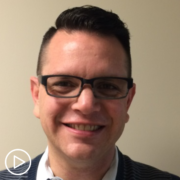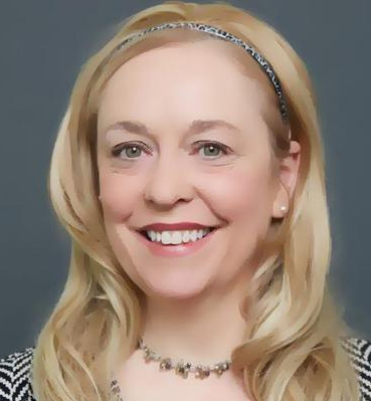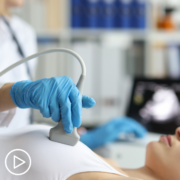CAR T-Cell Therapy Care Partners | What Do You Need to Know About the Process? from Patient Empowerment Network on Vimeo.
What is the role of the care partner when a loved one is undergoing CAR T-cell therapy? Registered nurse and transplant coordinator Sarah Meissner is joined by Adrienne, a care partner, as they discuss the importance of care partners in the CAR T-cell therapy process. They review key questions to ask the healthcare team, explain patient side effects to monitor for, and share resources that can help support care partners throughout their loved one’s recovery period.
Sarah Meissner, RN, BSN, BMTCN, is a Blood and Marrow Transplant and Related Donor Search Coordinator at the Colorado Blood Cancer Institute. Adrienne is a Care Partner to her husband, who underwent CAR T-cell therapy.
See More from The Care Partner Toolkit: CAR T-Cell Therapy
Download Resource Guide
Related Resources:
Transcript:
Katherine Banwell:
Hello and welcome. I’m Katherine Banwell, your host for today’s program. Today, we’re going to discuss the role that care partners play in supporting their loved ones who are going through CAR T-cell therapy. Before we meet our guest, let’s review a few important details. The reminder email you received about this webinar contains a link to a program resource guide. If you haven’t already, click that link to access information to follow along during the program. At the end of this webinar, you will receive a link to a program survey. This will allow you to provide feedback about your experience today and it will help us plan future webinars.
Finally, before we get into the discussion, please remember that this program is not a substitute for seeking medical advice. Please refer to your healthcare team about what might be best for you.
Well, let’s meet our guest today. Joining me is Sarah Meissner. Sarah, welcome. Would you please introduce yourself?
Sarah Meissner:
Hi. My name is Sarah Meissner. I am a transplant and CAR T coordinator at the Colorado Blood Cancer Institute in Denver. And I have been working with blood cancer patients for 13 years and in my current role for 8.
Katherine:
Excellent. Thank you so much for being with us today. And here to share the care partner perspective is Adrienne. Adrienne, welcome to the program.
Adrienne:
Thank you for having me.
Katherine:
So, let’s begin by learning more about Sarah’s role. Sarah, can you explain what you do as a transplant coordinator at CBCI?
Sarah Meissner:
Of course. So, I like to say that as a coordinator, I am kind of the travel agent of the CAR T process. So, I meet with the patients when they are determined to be a candidate for CAR T-cell therapy.
And I act as kind of the intermediary between the patient and the care team. I help them get set up for all of their appointments as well as provide education for what’s going to be occurring.
Katherine:
Okay. So, when someone is undergoing CAR T-cell therapy, who are the essential members on their healthcare team besides you?
Sarah Meissner:
We have a pretty big care team. So, of course, we have the physician who is kind of at the helm for determining the care plan. We also have financial coordinators, social workers, dieticians, as well as the nursing team who will be providing the care to the patient.
Katherine:
So, how many people could be on a team?
Sarah Meissner:
It could be as many as 10. It just depends on the individual patient’s needs and how different people can help.
Katherine:
How do you, specifically, work with CAR T-cell patients and care partners?
Sarah Meissner:
So, I am their main contact during the process. So, any questions that come up that I can help with, I’m there via phone, email, in person meetings. I also am big in education. So, sitting with the patient when they’re in clinic and helping them understand what this treatment is, why we’re doing it, what they can expect and just helping them through the process.
Katherine:
Great. Adrienne, I’d like to turn to now to you and find out more about your experience. How did all of this begin for you and your husband?
Adrienne:
This all began with my husband and I, we both are very active, and we work out a lot. And he had some pain in his lower back and his groin area.
And we started going to physical therapy and a chiropractor. And the chiropractor was doing besides just chiropractic, he also did physical therapy stuff, too. His pain wasn’t getting any better. And after a few months, he called to get an MRI and that’s when they found his myeloma was in the MRI. Because of his age, he was diagnosed in 2018 at I’m trying to think how old he was. He was around 37. So, it was a very early diagnosis maybe but he definitely was on the young side of having this kind of cancer. So, that’s how we found out.
And then after that, it was just kind of a whirlwind on how we would care for him and what we needed to do to get him better.
Katherine:
Yeah. It must have been hard.
Adrienne:
Yeah. It was hard.
Katherine:
What was the process like for you as his main care partner?
Adrienne:
My role once he was diagnosed was just to do everything I could to find out. We didn’t really know about the disease before. So, to find out what the best care for him was. We did a lot of research. We ended up going to several doctors before deciding what treatment plan we were going to go with.
And then, he had some ups and downs, some failed treatments. And that’s where we went into CAR T, because we had so many failed treatments before.
Katherine:
Did you feel like you were doing a lot of research? Were you doing a lot of homework Googling stuff?
Adrienne:
Well, kind of trying to but we were also told not to do that too much, because it’s always the worst-case scenario online. But we did that somewhat and we got as much information from each institute we went to. And we went to, like I said, we went through three, and then we ended up at CBCI at the end where we are now.
So, we started to discover that the first few lines of treatment were pretty standard. When you’re put into a situation where you find out your spouse has cancer, all you want to do is you want to find the magic miracle that’s going to cure them. And we did have to just go through the steps of standard care first. And we’re hoping that this CAR T-cell works. It’s working really well right now.
Katherine:
I was just going to ask you, how are you and your husband doing now?
Adrienne:
We’re doing pretty good. He’s still very tired. He’s, actually, taking a nap right now. And he has ups and downs. He definitely feels a lot better overall. He is getting back to normal life. But there are times where he just doesn’t feel quite right and has some physical pain and some cognitive issues.
And we don’t really know if that’s from CAR T alone or if it’s also just from the last five years of having chemo and bone marrow transplant and all of the care before the CAR T-cell.
Katherine:
Sarah, can you answer that question about cognitive difficulties that Adrienne’s husband is having?
Sarah Meissner:
Yeah. So, it is pretty common to have what we call chemo brain after any treatment really. And in the case of Adrienne’s husband, he’s had several rounds of chemotherapy going into the CAR T treatment. So, it can be kind of an accumulative effect of all of that. And it is something that people struggle with post-treatment.
It’s kind of a brain fog, not remembering things. So, working with the team and neurologists can be helpful in some cases. So, that is something that we see.
Katherine:
Well, let’s shift the conversation a bit to learn more about how the CAR T-cell therapy process works. Sarah, would you walk us through the typical path?
Sarah Meissner:
Of course. So, it is a pretty protracted treatment. It starts off when the patient is determined to be a CAR T-cell candidate.
At that point, we are looking at getting testing to confirm that eligibility so based off of disease process as well as performance status and organ function. So, there are a series of tests that are done, and then those are sent to the insurance company in order to obtain authorization for treatment. After we have received the authorization, then the patient consents for treatment with their physician where we review the plan of care, side effects, risks, benefits, all of that. And then the T-cell collection takes place. So, this is a one day, outpatient procedure. We put a temporary catheter into the patient that goes into their neck and we use this to collect the T cells.
So, the patient gets hooked up to an apheresis machine, which kind of looks like a dialysis machine. And it filters the patient’s blood.
It takes blood out of the patient’s body, goes into the machine into a giant centrifuge where the blood is separated into different densities. And then, the T-cells are extracted from the density of the blood where it is and then, taken out and collected in a bag. This is a three- to four-hour process usually and then, when we are finished, we are left with a bag of T cells. Those T cells are then shipped off to a manufacturing site for the specific pharmaceutical company that is going to be manufacturing the patient’s T-cells. And that can take anywhere from three to eight weeks depending on the product.
During this time period, most patients have an active blood cancer that is going to need some treatment while we’re waiting for those cells. So, it is something we call bridging therapy. They may or may not receive that depending on what’s going on in their case.
After the T cells are manufactured, they get shipped back to our center as a frozen block. And we have the patient come back in. They get a few days of chemotherapy. We call this lymphodepleting chemotherapy. So, this isn’t chemo that’s meant to treat the patient’s disease but to suppress their immune system so that when we put these CAR T cells back into their body, the patient’s immune system doesn’t fight them off before they can do their job. So, that’s typically two or three days depending on which products the patient is getting and which disease is being treated.
Then, they get a few days off and then, that frozen block of cells is brought out of the freezer, brought to the patient, thawed in a water bath that looks kind of like a hot dog cooker.
Katherine:
That’s an odd image.
Sarah Meissner:
There is water in there that’s heated to body temperature and the frozen block of cells is thawed.
And then, those cells are infused into the patient’s body and go to work to fight the patient’s cancer.
Katherine:
What is the care partner’s role in helping the patient through this process? And why are care partners so critical for a patient’s recovery?
Sarah Meissner:
So, the care partner is a huge part of this process. After the cells are infused, there is a 30-day close monitoring period. And it’s a requirement for our center that the patient have a 24/7 caregiver during that time. There are a lot of side effects that can happen, and the patient is not going to be able to drive for two months.
So, they need somebody with them at all times to be monitoring for these symptoms as well as bringing them to their appointments, helping them with their medications, day-to-day stuff at home as well.
Katherine:
Adrienne, if you don’t mind, what sort of side effects did your husband have?
Adrienne:
He had from the immunosuppressing chemotherapy, he had really low numbers for a while and that just made him feel pretty bad. And he didn’t have any really bad side effects where we had to go to the hospital. Well, I guess we did a few times. He had just a little bit of fever, which you have to report and make sure that it’s okay.
So, we did have to go twice. But it really didn’t end up being anything too bad. He did have a fall down the stairs at our house. So, if we did it different, I think because we had to be there every day for two weeks and the monitoring, I think that we would probably have rented a hotel that didn’t have these stairs just because he’s used to going up and down the stairs, but I don’t know if he just lost his footing. But it was extremely scary with everything else that he was going through. And that might have been part of the cognitive thing. I feel like most of his side effects, actually, started hitting months after the cognitive things.
But the stress was more on just caring for him and making sure that he was okay and just being ready just in case something happened.
Katherine:
Yeah. It’s like being on high alert 24/7.
Adrienne:
Correct.
Katherine:
Sarah, could you describe some of the common side effects?
Sarah Meissner:
Yeah. So, there are two main sets of side effects that we’re looking for with CAR T therapy. The first is something called cytokine release syndrome. So, this happens when the CAR T cells latch onto those cancer cells and kill them and stuff gets put out into the patient’s blood stream. That can cause what’s called a cytokine response. And it’s, basically, proteins that cause inflammation. So, common side effects that we see with that are fever, low blood pressure, high heart rate.
Some people need some oxygen. It looks very similar to what we would see in sepsis or a severe infection. The good news about that is there is a medication that’s very effective in treating cytokine release syndrome. And so, that’s why it’s important for the caregiver to notice these things and bring them into the hospital so they can get that treatment right away. The other set of side effects is something called neurotoxicity. So, if you think of the brain as a group of wires that is sending signals throughout the body, with neurotoxicity, those wires can kind of get jumbled. They’re not necessarily cut. This isn’t an irreversible thing.
They get jumbled and can kind of mix up those signals. So, we can see patients that are confused. Patients can have seizures. We start everybody on anti-seizure medication as a prevention method. They can get a tremor and we can see changes in their handwriting.
So, we assess for this twice a day during those first 14 days by asking them a simple set of five questions. To name certain objects, to count back from 100 by 10, ask them what day it is, that kind of stuff and then, to write out a sentence. And we can see subtle changes in that functioning in the handwriting. So, this like the cytokine release syndrome, if we start to see it, there are medications that we can use to treat it. We usually put people in the hospital for a little closer monitoring. But these are things that the caregiver usually will catch onto before the care team because they know them best.
And they can catch onto those subtle changes maybe in their personality or little confusion or stuff like that.
Katherine:
Well, that leads me to the next question, which is what sorts of questions should care partners be asking their team?
Sarah Meissner:
Yeah, definitely.
So, they should be asking what they should be looking for, what side effects would constitute something that they need to report. They should be asking, “Who are we reporting to, what phone number or who are we reporting these things to?” Those are the main things to be looking for. We use a home monitoring system at our center. So, maybe some specific questions about monitoring dependent on your center and how they’re having the caregiver look for these side effects.
Katherine:
Adrienne, based on your experience, are there any questions that you would recommend care partners ask their healthcare team?
Adrienne:
I think that it’s kind of one of those things where you have to experience it. I feel like I did have all of my questions answered.
But at the same time, you don’t really know what you’re getting into until it’s actually happening.
Katherine:
Right.
Adrienne: But back to the cytokine syndrome, my husband did have this effect where he had the high fever, and that’s why we went in. And we did get the Toci dose [tocilizumab], which is a special medicine that kind of calms the inflammation down. So, I think that some of the questions that I would have pretty much are what to expect but I was given that. And I think maybe it would be good to meet other people that had gone through this before you’re actually going through it.
I didn’t have that luxury, because my husband was only the second person in our hospital to do it. But to know what’s going on from another caregiver’s perspective would be nice.
Katherine:
Yeah. We’re going to talk about resources in a moment. But, Sarah, I wanted to ask you, “What are some of the common issues that care partners face?”
Sarah Meissner:
I think this is a very stressful time here. Your loved one is not feeling well, and there are these potential side effects. And so, that can cause a lot of stress on caregivers that they’re kind of the one in charge. They’re looking for these things. Of course, they want the best for their loved one. So, it can be a very stressful time.
Frequent appointments. Here in Denver, we have terrible traffic. So, if people live far away from the center, it’s fighting rush hour every morning to get here. That can add a lot of stress as well as if you have other things going on at home, too, other family members who need you, it’s a lot to take on.
Katherine:
Adrienne, what experiences or issues did you have in taking care of your husband?
Adrienne:
Well, we do have a child. She was 2 at the time. So, I did have to plan childcare pretty much every day for two weeks, which I am fortunate to have lots of friends and family here in Denver, so I was able to get that covered.
Katherine:
It’s a lot of responsibility for you.
It’s a higher level of responsibility, I guess, right, because you’re taking care of your child and now, your husband is very sick. And you want to make sure that everyone’s needs are being met.
Adrienne:
Right. And driving, like Sarah had said, the driving was an issue, because it was so far for us. There are potholes and with the little bit of change in mood and not feeling well, it was hard for him to be in the car so long and not getting to drive himself. So, I think that was not the best experience. I think if we did it next time, we would try and just be closer to the hospital.
And for me to take care of everybody else, I did make sure that I would try and work out and not being able to leave the house with him. So I work out in the living room just to get some of my own stress out, or I would have somebody come and watch him if I really wanted to go to a class to work out. And like I said before, we were very lucky to have his parents that live in town and then my mother and my sister. So, that’s something that is important to have a network of people to help you because I don’t know, depending on what you have on your plate. I think it would be almost impossible to do it all by yourself, especially if you have to work or you have children to take care of.
So, that’s some advice or what I’ve learned from this experience.
Katherine:
Yeah. Was it hard for you to take time for yourself? Did you feel guilty? I know a lot of people think “Oh, I need to focus all of my attention on my child or my sick spouse.” It can be difficult to say to yourself, “I really need to take half an hour or an hour,” and then, find somebody to help you out with the caregiving.
Adrienne:
Yes. I did find it difficult. And you just know that there is going to be an end in sight. You think,”If I can just last through the month so I did sacrifice.” But at the same time, my main concern was that my husband would get through this. So, I did feel a little guilty. And I would get a little bit of time.
But me, personally, I just wanted to push through that month and especially that first two weeks. And then, I knew that I would be back to doing the things I love.
Katherine:
Yes. Rather than looking too far forward, I guess it’s trying to get through every day each day. Yeah. I’m going to switch back to ask Sarah a question. Sarah, why is it so important that care partners communicate any issues with their healthcare team?
Sarah Meissner:
So, those side effects that we talked about, there are drugs that we can use to treat them, but they work best when we can get those drugs in as soon as possible. So, if we’re starting to see signs of cytokine release syndrome, we want to get that tocilizumab (Actemra) infused in the patient within two hours.
So, it’s really important that we know that these side effects are popping up so that we can treat it appropriately.
Katherine:
All right. We spoke about support a few moments ago. Sarah, this is, obviously, a very taxing experience for everyone, the patient and care partner. Where can care partners find support during this time looking outside family members and relatives nearby? What other resources are available?
Sarah Meissner:
Absolutely. I would encourage people to work with their local psychosocial team first. There may be support groups within the program that they’re receiving treatment at that could be helpful or, like Adrienne talked about, other patients or caregivers who have gone through this that they can be connected with.
There is also some great support resources through The Leukemia & Lymphoma Society. They do have caregiver support. They have patient support, connections with patients, and that kind of stuff. So, that is another good place to look as well as the different manufacturing groups that make these CAR T cells do have patient support groups as well. So, maybe some more information, maybe some caregiver resources. They’re all a little bit different but that would be another good place to look.
Katherine:
Adrienne, did you find any resources that you would recommend?
Adrienne:
Well, I used, and not on particularly CAR T cell but I do have one in there, but Facebook does have closed groups that you can join.
I did this for his bone marrow transplant. And I do get a lot of support on that particular one. It’s for spouses and caregivers in particular. So, look for that and there is one on CAR T cell but for multiple myeloma. But at the time, it was very new so there wasn’t a lot of back and forth on there. But you can really connect with people, and, of course, it’s not a substitute for any kind of medical advice. But it is nice to talk to people that are going through the same thing, especially with his bone marrow transplant. There were other caregivers that were, actually, doing it at the same time. So, that was kind of like a reassuring thing to have this little group of people that we knew were all doing it at the same time.
Katherine:
Yeah. That’s great support. Sarah, how can care partners make sure they’re taking care of themselves? What can they be doing?
Sarah Meissner:
I think it’s hard going through this process. The focus is so much on the patient and what they’re going through. And caregivers often forget that they have needs, too. So, taking the time to look within and recognize when you’re feeling stressed and maybe you need some support. Reaching out to friends and family is a great thing if you have that option. If you have the option to have somebody come in and hang out with the patient for a period of time, so you can go to a work out class or you can just go grab some groceries or go do something for yourself and have a few minutes that you’re not having to worry about watching the patient can be really a great thing for people.
Sometimes, if patients don’t have other support, caregivers will take the time that the patient is in clinic and being watched by the care team to maybe go run a quick errand or do something. And that’s definitely an option as well.
Katherine:
Adrienne, we talked about this, but do you have any advice for care partners as they begin the process?
Adrienne:
Yes. I would just say that it’s only temporary and that the first two weeks is really intense, but it definitely gets better. And just to keep your eyes peeled on all of those little things that might not be right, because it’s really important to get them back into clinic if they need it and to take a little time for yourself.
Katherine:
Yeah. Well, before we end the program, I’d like to get final thoughts from both of you. What message do you want to leave care partners with? Adrienne, let’s start with you. You may have already answered this question just a moment ago.
Adrienne:
The message that I think that we would like to give, my husband, too, is that this is a lot of work, but he has had a very successful remission. And it’s very promising, and we’re excited to have a long future with this. It’s much better than having chemo every week.
And it’s improved his quality of life. So, I think that as a caregiver, it’s a lot of work, but it’s definitely worth the work, because the end result, hopefully, will be life-changing.
Katherine:
Yeah. Sarah, do you have anything to add? What information would you like to leave care partners with?
Sarah Meissner:
Yeah. The care partners are such a crucial part of this process. Without them, we can’t provide this treatment. So, it’s a very important role, and we are very thankful that you are willing to do this for your loved one so that we can give them this treatment and, hopefully, get them into remission and have great results from that. So, make sure that you take the time that you need to be able to be there for your loved one and, again, just thank you for being willing to do this.
Katherine:
Well, Sarah and Adrienne, thank you so much for joining us today. This has been really great to talk to you both.
Sarah Meissner:
Thank you.
Adrienne:
Thank you.
Katherine:
And thank you to all of our partners. If you’d like to watch this webinar again, there will be replay available soon. You’ll receive an email when it’s ready. Also, don’t forget to take the survey immediately following this webinar. It will help us as we plan programs in the future. To access tools to help you become a proactive patient, visit Powerfulpatients.org. I’m Katherine Banwell.













